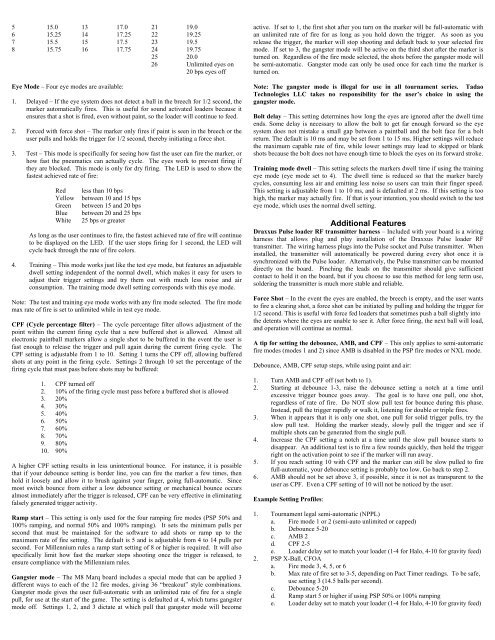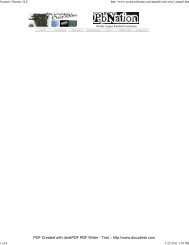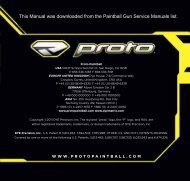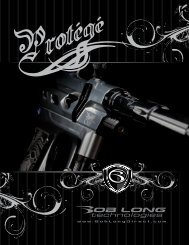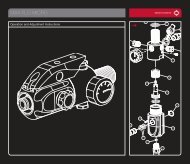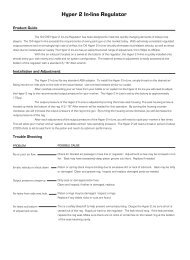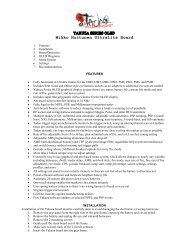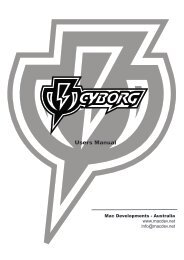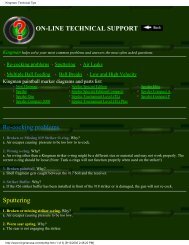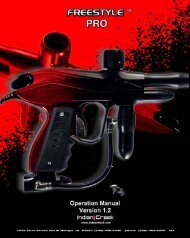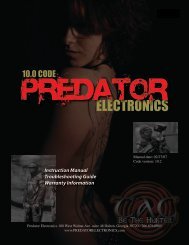Musashi 8 Marq Board Instructions - Mcarterbrown.com
Musashi 8 Marq Board Instructions - Mcarterbrown.com
Musashi 8 Marq Board Instructions - Mcarterbrown.com
Create successful ePaper yourself
Turn your PDF publications into a flip-book with our unique Google optimized e-Paper software.
5 15.0 13 17.0 21 19.06 15.25 14 17.25 22 19.257 15.5 15 17.5 23 19.58 15.75 16 17.75 24 19.7525 20.026 Unlimited eyes on20 bps eyes offEye Mode – Four eye modes are available:1. Delayed – If the eye system does not detect a ball in the breech for 1/2 second, themarker automatically fires. This is useful for sound activated loaders because itensures that a shot is fired, even without paint, so the loader will continue to feed.2. Forced with force shot – The marker only fires if paint is seen in the breech or theuser pulls and holds the trigger for 1/2 second, thereby initiating a force shot.3. Test – This mode is specifically for seeing how fast the user can fire the marker, orhow fast the pneumatics can actually cycle. The eyes work to prevent firing ifthey are blocked. This mode is only for dry firing. The LED is used to show thefastest achieved rate of fire:RedYellowGreenBlueWhiteless than 10 bpsbetween 10 and 15 bpsbetween 15 and 20 bpsbetween 20 and 25 bps25 bps or greaterAs long as the user continues to fire, the fastest achieved rate of fire will continueto be displayed on the LED. If the user stops firing for 1 second, the LED willcycle back through the rate of fire colors.4. Training – This mode works just like the test eye mode, but features an adjustabledwell setting independent of the normal dwell, which makes it easy for users toadjust their trigger settings and try them out with much less noise and airconsumption. The training mode dwell setting corresponds with this eye mode.Note: The test and training eye mode works with any fire mode selected. The fire modemax rate of fire is set to unlimited while in test eye mode.CPF (Cycle percentage filter) – The cycle percentage filter allows adjustment of thepoint within the current firing cycle that a new buffered shot is allowed. Almost allelectronic paintball markers allow a single shot to be buffered in the event the user isfast enough to release the trigger and pull again during the current firing cycle. TheCPF setting is adjustable from 1 to 10. Setting 1 turns the CPF off, allowing bufferedshots at any point in the firing cycle. Settings 2 through 10 set the percentage of thefiring cycle that must pass before shots may be buffered:1. CPF turned off2. 10% of the firing cycle must pass before a buffered shot is allowed3. 20%4. 30%5. 40%6. 50%7. 60%8. 70%9. 80%10. 90%A higher CPF setting results in less unintentional bounce. For instance, it is possiblethat if your debounce setting is border line, you can fire the marker a few times, thenhold it loosely and allow it to brush against your finger, going full-automatic. Sincemost switch bounce from either a low debounce setting or mechanical bounce occursalmost immediately after the trigger is released, CPF can be very effective in eliminatingfalsely generated trigger activity.Ramp start – This setting is only used for the four ramping fire modes (PSP 50% and100% ramping, and normal 50% and 100% ramping). It sets the minimum pulls persecond that must be maintained for the software to add shots or ramp up to themaximum rate of fire setting. The default is 5 and is adjustable from 4 to 14 pulls persecond. For Millennium rules a ramp start setting of 8 or higher is required. It will alsospecifically limit how fast the marker stops shooting once the trigger is released, toensure <strong>com</strong>pliance with the Millennium rules.Gangster mode – The M8 <strong>Marq</strong> board includes a special mode that can be applied 3different ways to each of the 12 fire modes, giving 36 “breakout” style <strong>com</strong>binations.Gangster mode gives the user full-automatic with an unlimited rate of fire for a singlepull, for use at the start of the game. The setting is defaulted at 4, which turns gangstermode off. Settings 1, 2, and 3 dictate at which pull that gangster mode will be<strong>com</strong>eactive. If set to 1, the first shot after you turn on the marker will be full-automatic withan unlimited rate of fire for as long as you hold down the trigger. As soon as yourelease the trigger, the marker will stop shooting and default back to your selected firemode. If set to 3, the gangster mode will be active on the third shot after the marker isturned on. Regardless of the fire mode selected, the shots before the gangster mode willbe semi-automatic. Gangster mode can only be used once for each time the marker isturned on.Note: The gangster mode is illegal for use in all tournament series. TadaoTechnologies LLC takes no responsibility for the user’s choice in using thegangster mode.Bolt delay – This setting determines how long the eyes are ignored after the dwell timeends. Some delay is necessary to allow the bolt to get far enough forward so the eyesystem does not mistake a small gap between a paintball and the bolt face for a boltreturn. The default is 10 ms and may be set from 1 to 15 ms. Higher settings will reducethe maximum capable rate of fire, while lower settings may lead to skipped or blankshots because the bolt does not have enough time to block the eyes on its forward stroke.Training mode dwell – This setting selects the markers dwell time if using the trainingeye mode (eye mode set to 4). The dwell time is reduced so that the marker barelycycles, consuming less air and emitting less noise so users can train their finger speed.This setting is adjustable from 1 to 10 ms, and is defaulted at 2 ms. If this setting is toohigh, the marker may actually fire. If that is your intention, you should switch to the testeye mode, which uses the normal dwell setting.Additional FeaturesDraxxus Pulse loader RF transmitter harness – Included with your board is a wiringharness that allows plug and play installation of the Draxxus Pulse loader RFtransmitter. The wiring harness plugs into the Pulse socket and Pulse transmitter. Wheninstalled, the transmitter will automatically be powered during every shot once it issynchronized with the Pulse loader. Alternatively, the Pulse transmitter can be mounteddirectly on the board. Pinching the leads on the transmitter should give sufficientcontact to hold it on the board, but if you choose to use this method for long term use,soldering the transmitter is much more stable and reliable.Force Shot – In the event the eyes are enabled, the breech is empty, and the user wantsto fire a clearing shot, a force shot can be initiated by pulling and holding the trigger for1/2 second. This is useful with force fed loaders that sometimes push a ball slightly intothe detents where the eyes are unable to see it. After force firing, the next ball will load,and operation will continue as normal.A tip for setting the debounce, AMB, and CPF – This only applies to semi-automaticfire modes (modes 1 and 2) since AMB is disabled in the PSP fire modes or NXL mode.Debounce, AMB, CPF setup steps, while using paint and air:1. Turn AMB and CPF off (set both to 1).2. Starting at debounce 1-3, raise the debounce setting a notch at a time untilexcessive trigger bounce goes away. The goal is to have one pull, one shot,regardless of rate of fire. Do NOT slow pull test for bounce during this phase.Instead, pull the trigger rapidly or walk it, listening for double or triple fires.3. When it appears that it is only one shot, one pull for solid trigger pulls, try theslow pull test. Holding the marker steady, slowly pull the trigger and see ifmultiple shots can be generated from the single pull.4. Increase the CPF setting a notch at a time until the slow pull bounce starts todisappear. An additional test is to fire a few rounds quickly, then hold the triggerright on the activation point to see if the marker will run away.5. If you reach setting 10 with CPF and the marker can still be slow pulled to firefull-automatic, your debounce setting is probably too low. Go back to step 2.6. AMB should not be set above 3, if possible, since it is not as transparent to theuser as CPF. Even a CPF setting of 10 will not be noticed by the user.Example Setting Profiles:1. Tournament legal semi-automatic (NPPL)a. Fire mode 1 or 2 (semi-auto unlimited or capped)b. Debounce 5-20c. AMB 2d. CPF 2-5e. Loader delay set to match your loader (1-4 for Halo, 4-10 for gravity feed)2. PSP X-Ball, CFOAa. Fire mode 3, 4, 5, or 6b. Max rate of fire set to 3-5, depending on Pact Timer readings. To be safe,use setting 3 (14.5 balls per second).c. Debounce 5-20d. Ramp start 5 or higher if using PSP 50% or 100% rampinge. Loader delay set to match your loader (1-4 for Halo, 4-10 for gravity feed)


